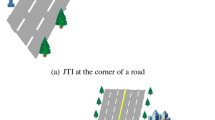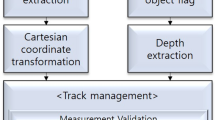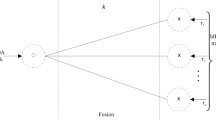Abstract
This paper proposes an unbiased finite impulse response filter and track management algorithm for multi-target tracking (MTT) with imperfect detection probability. Targets cannot be detected under MTT for various reasons, including sensor failure and screening by other targets. Despite the temporary missed detection, the proposed MTT algorithm robustly tracks targets under MTT conditions by replacing the missed detection with recently detected target measurement. The track is deleted on the track table when consecutive detection failure exceeding missing horizon occurs. Computational time for the proposed MTT algorithm is significantly less than that for existing MTT algorithm based finite impulse response filters due to the proposed track update and track management algorithm. Simulation and experimental vehicle and pedestrian tracking results verify outstanding tracking accuracy and shorter calculation times for the proposed algorithm.
Similar content being viewed by others
References
D. Song, R. Tharmarasa, T. Kirubarajan, and X. N. Fernando, “Multi-vehicle tracking with road maps and car-following models,” IEEE Transactions on Intelligent Transportation Systems, vol. 19, no. 5, pp. 1375–1386, 2017.
Y. T. Tesfaye, E. Zemene, A. Prati, M. Pelillo, and M. Shah, “Multi-target tracking in multiple non-overlapping cameras using constrained dominant sets,” arXiv preprint arXiv:1706.06196, 2017.
F. García, A. Prioletti, P. Cerri, and A. Broggi, “PHD filter for vehicle tracking based on a monocular camera,” Expert Systems with Applications, vol. 91, pp. 472–479, 2018.
G.-Z. Cui, S.-Y. Xu, Q. Ma, Z. Li, and Y.-M. Chu, “Command-filter-based distributed containment control of nonlinear multi-agent systems with actuator failures,” International Journal of Control, vol. 91, no. 7, pp. 1708–1719, 2018.
L.-N. Long, J.-W. Lu, S.-Y. Xu, and Y.-M. Chu, “Reference model-based containment control of multi-agent systems with high-order dynamics,” IET Control Theory and Applications, vol. 8, no. 10, pp. 796–802, 2014.
J. Li, S.-Y. Xu, Y.-M. Chu, and H. Wang, “Distributed average consensus control in networks of agents using outdated states,” IET Control Theory and Applications, vol. 4, no. 5, pp. 746–758, 2010.
Y. Qu, S.-Y. Xu, C. Song, Q. Ma, Y.-M. Chu, and Y. Zou, “Finite-time dynamic coverage for mobile sensor networks in unknown environments using neural networks,” Journal of The Franklin Institute, vol. 351, no. 10, pp. 4838–4849, 2014.
Z.-Q. Zhang, S.-Y. Xu, Y. Guo, and Y.-M. Chu, “Robust adaptive out-feedback control for a class of nonlinear systems with time-varying actuator faults,” International Journal of Control, vol. 24, no. 9, pp. 743–759, 2010.
S. He, H.-S. Shin, and A. Tsourdos, “Multi-sensor multitarget tracking using domain knowledge and clustering,” IEEE Sensors Journal, vol. 18, no. 19, pp. 8074–8084, 2018.
X. Lyu and J. Wang, “Sequential multi-sensor JPDA for target tracking in passive multi-static radar with range and doppler measurements,” IEEE Access, vol. 7, pp. 34488–34498, 2019.
D. D. Mu, G. F. Wang, and Y. S. Fan, “Tracking control of podded propulsion unmanned surface vehicle with unknown dynamics and disturbance under input saturation,” International Journal of Control, Automation and Systems, vol. 16, no. 4, pp. 1905–1915, 2018.
Y. Bar-Shalom and T. E. Fortmann, Tracking and Data Association, Academic Press, Boston, 1988.
Y. Bar-Shalom, T. Kirubarajan, and X. Lin, “Probabilistic data association techniques for target tracking with applications to sonar, radar and EO sensors,” IEEE Aerospace and Electronic Systems Magazine, vol. 20, no. 8, pp. 37–56, 2005.
M. Beard, B.-T. Vo, and B.-N. Vo, “Bayesian multi-target tracking with merged measurements using labelled random finite sets.” IEEE Transactions on Signal Processing, vol. 63, no. 6, pp. 1433–1447, 2015.
S. H. Rezatofighi, S. Gould, B. T. Vo, B.-N. Vo, K. Mele, and R. Hartley, “Multi-target tracking with time-varying clutter rate and detection profile: application to time-lapse cell microscopy sequences,” IEEE Transactions on Medical Imaging, vol. 34, no. 6, pp. 1336–1348, 2015.
K. Fukunaga and T. E. Flick, “An optimal global nearest neighbor metric,” IEEE Transactions on Pattern Analysis and Machine Intelligence, no. 3, pp. 314–318, 1984.
T. Fortmann, Y. Bar-Shalom, and M. Scheffe, “Sonar tracking of multiple targets using joint probabilistic data association,” IEEE Journal of Oceanic Engineering, vol. 8, no. 3, pp. 173–184, 1983.
S. S. Blackman, “Multiple hypothesis tracking for multiple target tracking,” IEEE Aerospace and Electronic Systems Magazine, vol. 19, no. 1, pp. 5–18, 2004.
R. P. Mahler, “Multitarget Bayes filtering via first-order multitarget moments,” IEEE Transactions on Aerospace and Electronic Systems, vol. 39, no. 4, pp. 1152–1178, 2003.
B.-N. Vo and W.-K. Ma, “The Gaussian mixture probability hypothesis density filter,” IEEE Transactions on Signal Processing, vol. 54, no. 11, pp. 4091–4104, 2006.
H. Heffes, “The effect of erroneous models on the Kalman filter response,” IEEE Transactions on Automatic Control, vol. 11, no. 3, pp. 541–543, 1966.
C. Price, “An analysis of the divergence problem in the Kalman filter,” IEEE Transactions on Automatic Control, vol. 13, no. 6, pp. 699–702, 1968.
R. Fitzgerald, “Divergence of the Kalman filter,” IEEE Transactions on Automatic Control, vol. 16, no. 6, pp. 736–747, 1971.
K. Samuel and J. W. Choi, “Improved IMM filter for tracking a highly maneuvering target with mixed system noises,” International Journal of Control, Automation and Systems, vol. 16, no. 6, pp. 2763–2771, 2018.
Y. S. Shmaliy, “Linear optimal FIR estimation of discrete time-invariant state-space models,” IEEE Transactions on Signal Processing, vol. 58, no. 6, pp. 3086–3096, 2010.
J. M. Pak, C. K. Ahn, C. J. Lee, P. Shi, M. T. Lim, and M. K. Song, “Fuzzy horizon group shift FIR filtering for nonlinear systems with Takagi-Sugeno model,” Neurocomputing, vol. 174, pp. 1013–1020, 2016.
S. H. You, J. M. Pak, C. K. Ahn, P. Shi, and M. T. Lim, “Unbiased finite-memory digital phase-locked loop,” IEEE Transactions on Circuits and Systems II- Express Briefs, vol. 63, no. 8, pp. 798–802, 2016.
J. M. Pak, C. K. Ahn, P. Shi, Y. S. Shmaliy, and M. T. Lim, “Distributed hybrid particle/FIR filtering for mitigating NLOS effects in TOA-based localization using wireless sensor networks,” IEEE Transactions on Industrial Electronics, vol. 64, no. 6, pp. 5182–5191, 2017.
C. J. Lee and M. T. Lim, “Fuzzy H∞ fir filtering for T-S fuzzy systems with quantization and packet dropout,” International Journal of Control, Automation and Systems, vol. 16, no. 3, pp. 961–971, 2018.
C. J. Lee, J. M. Pak, C. K. Ahn, K. M. Min, P. Shi, and M. T. Lim, “Multi-target FIR tracking algorithm for Markov jump linear systems based on true-target decision-making,” Neurocomputing, vol. 168, pp. 298–307, 2015.
Y. Bar-Shalom and X.-R. Li, Estimation and Tracking: Principles, Techniques, and Software, Artech House, Inc, Norwood, MA, 1993.
L. Xiuying and S. Sun, “H∞ control for networked stochastic non-linear systems with randomly occurring sensor saturations, multiple delays and packet dropouts,” IET Control Theory and Applications, vol. 11, no. 7, pp. 2954–2963, 2017.
L. Xiuying and S. Sun, “Observer-based H∞ control for networked systems with bounded random delays and consecutive packet dropouts,” International Journal of Robust and Nonlinear Control, vol. 24, no. 17, pp. 2785–2802, 2014.
Y. S. Shmaliy, S. Zhao, and C. K. Ahn, “Unbiased finite impluse response filtering: an iterative alternative to Kalman filtering ignoring noise and initial conditions,” IEEE Control Systems, vol. 37, no. 5, pp. 70–89, 2017.
S. H. You, C. K. Ahn, Y. S. Shmaliy, and S. Zhao, “Minimum weighted Frobenius norm discrete-time FIR filter with embedded unbiasedness,” IEEE Transactions on Circuits and Systems II: Express Briefs, 2018.
W. H. Kwon and S. H. Han, Receding Horizon Control: Model Predictive Control for State Models, Springer Science & Business Media, 2006.
L. Stanislas and T. Peynot, “Characterisation of the Delphi electronically scanning radar for robotics applications,” Proc. of ARAA Australasian Conference on Robotics and Automation, ARAA, 2015.
Y. Bar-Shalom, F. Daum, and J. Huang, “The probabilistic data association filter,” IEEE Control Systems, vol. 29, no. 6, pp. 82–100, Dec. 2009.
D. Schuhmacher, B.-T. Vo, and B.-N. Vo, “A consistent metric for performance evaluation of multi-object filters,” IEEE Transactions on Signal Processing, vol. 56, no. 8, pp. 3447–3457, 2008.
A. Miron, S. Ainouz, A. Rogozan, and A. Bensrhair, “Cross-comparison census for colour stereo matching applied to intelligent vehicle,” Electronics Letters, vol. 48, no. 24, pp. 1530–1532, November 2012.
J. Mikulski, Activities of Transport Telematics, SpringerVerlag, Berlin Heidelberg, 2013.
Q. H. Do, H. Tehrani, S. Mita, M. Egawa, K. Muto, and K. Yoneda, “Human drivers based active-passive model for automated lane change,” IEEE Intelligent Transportation Systems Magazine, vol. 9, no. 1, pp. 42–56, Spring 2017.
X. Wei, Z. Guo, M. Guo, and X. Liu, “Disturbance observer-based anti-disturbance control for a class of stochastic systems,” Proc. of Chinese Control Conference (CCC), pp. 2860–2864, 2015.
X. Wei, H. Zhang, S. Sun, and H. R. Karimi, “Composite hierarchical antidisturbance control for a class of discrete-time stochastic systems,” International Journal of Robust and Nonlinear Control, vol. 28, no. 9, pp. 3292–3202, 2018.
Author information
Authors and Affiliations
Corresponding author
Additional information
Publisher’s Note Springer Nature remains neutral with regard to jurisdictional claims in published maps and institutional affiliations.
Recommended by Associate Editor SeungKeun Kim under the direction of Editor Chan Gook Park. This research was supported by the Basic Science Research Program through the National Research Foundation of Korea (NRF) funded by the Ministry of Education (Grant No. NRF-2016R1D1A1B01016071).
Chang Joo Lee received his B.S. degree in the School of Electronic Engineering from Soongsil University, Seoul, Korea in 2012. Since 2012, he has been a Ph.D. candidate in the School of Electrical Engineering, Korea University. His current research interests include fuzzy systems, neural networks, robust control, FIR filters, finite memory controls, nonlinear systems, and advanced driver assistance systems.
Sang Kyoo Park received his B.S. degree in the School of Electrical Engineering from Korea University, Seoul, Korea in 2016. Since 2016, he has been a Ph.D. candidate in the School of Electrical Engineering, Korea University. His current research interests include deep learning, computer vision, sensor fusion and advanced driver assistance systems.
Myo Taeg Lim received his B.S. and M.S. degrees in Electrical Engineering from Korea University, Seoul, Korea, in 1985 and 1987, respectively. He also received his M.S. and Ph.D. degrees in Electrical Engineering from Rutgers University, NJ, USA, in 1990 and 1994, respectively. He was a Senior Research Engineer with the Samsung Advanced Institute of Technology and a Professor in the Department of Control and Instrumentation, National Changwon University, Korea. Since 1996, he has been a Professor in the School of Electrical Engineering at Korea University. His research interests include optimal and robust control, vision based motion control, and autonomous mobile robots. He is the author or coauthor of more than 80 journal papers and two books (Optimal Control of Singularly Perturbed Linear Systems and Application: High-Accuracy Techniques, Control Engineering Series, Marcel Dekker, New York, 2001; Optimal Control: Weakly Coupled Systems and Applications, Automation and Control Engineering Series, CRC Press, New York, 2009). Prof. Lim currently serves as an Editor for International Journal of Control, Automation, and Systems. He is a Fellow of the Institute of Control, Robotics and System, and a member of the IEEE and Korean Institute of Electrical Engineers.
Rights and permissions
About this article
Cite this article
Lee, C.J., Park, S.K. & Lim, M.T. Multi-target Tracking and Track Management Algorithm Based on UFIR Filter With Imperfect Detection Probability. Int. J. Control Autom. Syst. 17, 3021–3034 (2019). https://doi.org/10.1007/s12555-018-0439-5
Received:
Revised:
Accepted:
Published:
Issue Date:
DOI: https://doi.org/10.1007/s12555-018-0439-5




